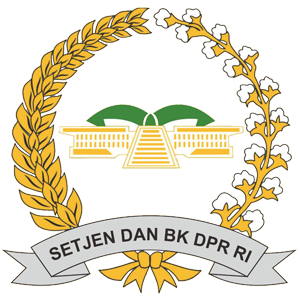PROSPEK KERJASAMA ASEAN PASCA RATIFIKASI PIAGAM ASEAN
Abstract
Since December 15, 2008, ASEAN will no longer be run based on Bangkok Declaration but ASEAN Charter. With this change, ASEAN is not again an informal organization but has become a formal one since it has now a clear rule and it is administered as legal entity, which focus its activities on people to people relationship. Because of this, too, ASEAN wants to show its existence as an effective organization due to the reason that all of its decisions could be binding and its success in the future would be determined not only by its leaders but also its societies.
Keywords
Full Text:
UntitledReferences
Buku
Brian Job, "Track II Diplomacy: ldeational Contribution to the Evolving Asia Security Order", dalam Muthiah Alagappa (ed), Asia Security Order, Stanford University Press, 2002.
Carolina Hernandez, sebagaimana di kutip dalam CSIS, "An ASEAN, of the People, by the People, for the People", Report of the First ASEAN's People Assembly, Batam, Indonesia, 2426 November 2000.
Donald K. Emmerson, Hard Chaises: Security,Democracy and Regionalism in Southeast Asia, ISEAS, Singapura, 2009.
James Luhulima, Asia Tenggara dan Negara Luar yang Mempengaruhinya: Pendekatan Politik dan Keamanan, PT Gramedia, 1998.
Jesus P. Estanislao, "Internal Dynamics of One Southeast Asia: Economic and Social Aspects", dalam Hadi Soesastro (ed.), One Southeast Asia In a New Regional and International Setting, CSIS, Jakarta, 1997.
Leo Suryadinata, "Toward An ASEAN Charter: Promoting an Asean Identity", dalam Rudolfi C. Severino (ed.), Framing the ASEAN Charter: An/SEAS Perspective, ISEAS, Singapura, 2005.
Liao Shaolian, "ASEAN Model in International Economic Cooperation", hal.151, dalam dalam Hadi Soesastro (ed.), One Southeast Asia In a New Regional and International Setting, CSIS, Jakarta, 1997.
Louise Diamond, Multi-Track Diplomacy:A Systems Approach to Peace, Third Edition, Kumarian Press, West Hartford, Connecticut, 1996.
Marlene Ramirez, "ASIADHRA and ASEAN: A Case Study on the Process of Civil Society Engagement with a Regional Intergovernmental Organization", FIM Forum 2008, Montreal, Kanada.
M. Rajaretnam, "Principles in Crisis: The Need for New Directions", dalam Kao Him Hourn, ed, ASEAN's Non-Interference Policy: Principle Under Pressure", ASEAN Academic Press, London, 2002.
Rodolfo Severino, "Framing the ASEAN Charter: An ISEAS Perspective", dalam Rodolfo Severino (ed.), Framing The ASEAN Charter: An ISEAS Perspective, ISEAS Publications, Singapura, 2005.
Jurnal
Alexander C. Chandra, "Indonesia's NonState Actors in ASEAN: A New Regionalism Agenda for Southeast Asia, Contemporary Southeast Asia, Vol. 26, No. 1, 2004.
Bantarto Sandora, "ASEAN Moves Toward Modern Oranization", The Indonesia Quarterly, Vol 36, No. 5, 2007.
Christopher B. Robert,"TheASEAN Community:Trusting Thy Neighbour", RSIS Commentaries, No. 110,22 Oktober 2007.
Dalia Dassa Kaye, "Rethinking Track Two Diplomacy: The Middle East and SouthAsia", Clingendael Diplomacy Papers, No. 3, Netherland Institute of International Relations, Juni 2005.
Elena Asciutti, "The ASEAN Charter:An Analysis", Perspectives on Federalism, Vol. 2, Issue 1, 2010.
Gillian Goh, "The ASEAN Way: Non Intervention and ASEAN Role in Conflict Management", Stanford Journal of East Asian Affairs, Vol. 3, No. 1, Spring 2003.
Hadi Soesastro, ASEAN: Regional Economic Cooperation and Its Institutionalization, Working Paper Series, No 71, CSIS, Jakarta, 2003.
Herman Joseph S. Kraft, A Charter for ASEAN: Challenges and Prospects for Community Building", Indonesia Quarterly, Vol. 36, No. 34, 2008.
Mely CaballeroAnthony, "The ASEAN Charter: An Opportunity Missed or One That Cannot be Missed?", Southeast Asian Affairs 2008, Institute of Southeast Asian Studies, Singapore, 2008.
Michael E. Jones, "Forging an ASEAN Identity: The Challenge to Construct a Share Destiny", Contemporary Southeast Asia, Vol. 26, No. 1, 2004.
Rizal Sukma, "Building theASEAN Community,How Useful Is theAsean Charter, dalam The Indonesia Quarterly, Vol. 36, No. 34, 2008.
See Seng Tan, "Nonofficial Diplomacy in Southeast Asia: "Civil Society" or "Civil Service", Contemporary Southeast Asia 27, no. 3, 2005.
Termsak Chalermpalanupap, "Institutional Reform: One Charter, Three Communities, Many Challenges", dalam Donald K. Emmerson (ed.), Hard Chaises: Security, Democracy and Regionalism in Southeast Asia, ISEAS Publishing, Singapura, 2009.
"Understanding theASEAN Charter and theASEAN Economic Blueprint", AFA and Asiadharra Issue Paper, Vol. 3, No. 1, Februari 2008.
Surat Kabar
"lndustri di Pulau Terluar Digalakkan", Media Indonesia, 19 Juli 2010, hal. 14.
Jusuf Wanandi, "The ASEAN Summit and Indonesia's National Interest", dalam The Jakarta Post, 19 Maret 2009.
Keith 8. Richburg, "The Changing Calculus of Asia", dalam International Herald Tribune, 17 Desember 1997.
Rene L. Pattiradjawane, "Membangun ASEAN Baru", Kompas, 15 Juni 2010.
"RI Sesalkan Aksi Sweeping", Kompas, 11 September 2009.
Tommy Koh, "ASEAN Charter at One: A Thriving Tiger Pup", The Straits Times, 09 Desember 2009.
Internet (produk individual)
Ali Alatas, "Piagam ASEAN Kebutuhan Mencapai lntegrasi, Tabloid Diplomas, edisi April 2008 dalam http://tabloiddiplomasi.com/,diakses 29 Januari 2010.
John Mclean, Will ASEAN's New Charter Bring Greater Cooperation?, dalam http//:www.Development Asia.mht, diakses 24April 2010.
Kim Seng Phar, Asia's Informal Diplomacy: Track Two Discussion and Regionalism", Media, Vol. 23, No.1, Spring 2001 dalam http://www.harvardir.org/articles/998/,diakses 12 Oktober 2009
Ong Keng Yong, "What's the Difference Between ASEAN Past and Present", makalah yang disajikan dalam 2nd ASEAN-Asia Forum yang diselenggarakan oleh Singapore Institute of International Affair, Singapura, 17 April 2009, dalam http://www.siiaonline.org/?g=events/2ndasean andasiaforum, diakses 26 Mei 2010.
Pokpon Lawansiri, "ASEAN: Peopleoriented or disoriented?, Inquirer.net, 29 November 2009, diakses tanggal 29 Januari 2010.
Internet(produk non individual)
"Analysis of the ASEAN Charter", SAPA, 18 Nov 07, dalam http://www.asiasapa.org, diakses 18 Desember2007.
Makalah
"Masalah Kegunaan dan Masa depan ASEAN Charter", CSIS, makalah yang disajikan dihadapan Komisi I DPRRI, Jakarta, 4 Februari 2008.
lnforman Utama
Yusfa Hendry, Kepala Bagian Humas Pemko Batam.
Nada Faza Soraya, Ketua Kadin Batam.
Ir. Soeripno, Kepala Bappeda Kepri.

This work is licensed under a Creative Commons Attribution-NonCommercial-ShareAlike 4.0 International License.
Refbacks
- There are currently no refbacks.


 Humphrey Wangke
Humphrey Wangke


